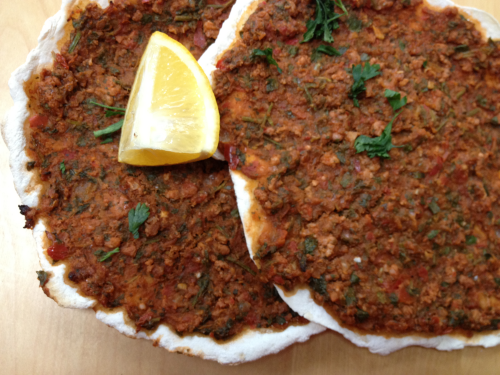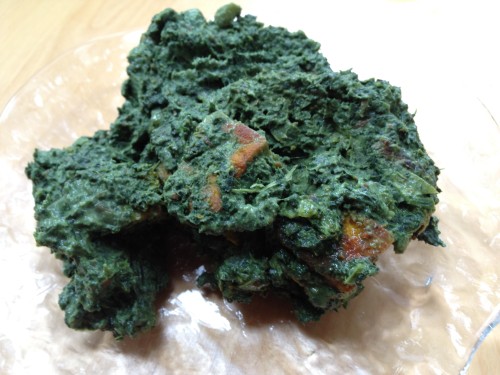
My family and I first tasted lahmajoun at a street fair in New York City. I was probably eight or ten years old. I think it was an Armenian festival in honor of St. Vartan. It fit the formula of some of the best New York street fairs: It honored a saint probably unknown to people outside of the culture in question, and it featured old women making delicious things you should not pass up.
Lahmajoun are incredibly tasty pizza-like creations, so thin you can roll them up when you eat them, preferably piping hot and drizzled with lemon juice. They commonly have lamb, although could be made with other ground meats instead. A vegan version could probably substitute finely-chopped sautéed mushrooms for the meat, although I think the lamb is what makes this recipe particularly tasty.
After we discovered lahmajoun, we went back to the festival in subsequent years to buy stacks of them and keep them in the freezer. But after a few years we stopped going. Maybe the street fair no longer happened. Maybe my parents forgot.
For years the taste of lahmajoun stayed a memory. Then the craving started creeping in as I thought about foods I grew up with and hadn’t tasted in years. I hunted for lahmajoun. I couldn’t find them in Seattle. I ate some in Los Angeles, where there is a sizable Armenian population.
Then I found out I was gluten intolerant. This wasn’t the end of the world, since I try not to eat all that many refined carbohydrates anyway. But I still craved a few foods, lahmajoun among them.
I don’t normally plug products (which means the people who have me on their email lists for product-plugging might as well send me pictures of kittens instead; I’ll pay more attention to those), but I’ve been appreciating Manini’s, the little gluten-free flour company that’s been selling at the U-District farmers market. [Update: That was many years ago, and they no longer sell at farmers markets, but do sell in Seattle grocery stores and coops, as well as online.] Their flour behaves pretty much just like pastry flour. Discovering this is probably not the best thing for my health, but does make me happy when I want some perfect pie or to make my grandmother’s hamantaschen recipe.
So I decided to try using a very thin version of the Manini’s pizza dough recipe for a batch of lahmajoun. I consulted a range of different topping recipes and came up with a combination that tasted familiar. It worked perfectly. The result was a Proust-like experience, sending me to a memory-street in Manhattan, where I was eating a freshly-rolled lahmajoun for the first time.
I made these for a friend’s party in December and again for Pi Day. Here’s the recipe.
~
Gluten-free Lahmajoun
- 1/2 batch Manini’s gluten-free pizza dough recipe
- 3/4 lb ground lamb (grass-fed)
- 1 yellow onion
- a few cloves of garlic
- 1 small bunch Italian parsley
- 1 medium bunch fresh mint
- 1 red bell pepper
- 2/3 jar of tomato sauce or equivalent homemade tomato sauce or chopped tomatoes. Some people add tomato paste.
- spices to taste (pretty generous quantities): paprika, cumin, turmeric, allspice
- a little bit of ground coriander (optional)
- a little bit of chili pepper (optional)
- salt
- olive oil or other favorite cooking fat
- lemon wedges (Meyer lemon is nice)
1. Prepare pizza dough recipe.
2. While dough is refrigerating, work on the topping. Preheat oven to 425F-450F, depending how hot your oven runs.
3. In a food processor, combine the onion (pre-cut into a few chunks), red pepper (seeded and cut into chunks), garlic cloves, parsley, mint, and optional bit of chili pepper.
4. Heat oil. Add ground lamb and stir. Add salt, spices and tomato sauce or tomatoes, and let it cook at low heat together for a few minutes.
5. Stir in mixture from the food processor. Cook on low heat for about fifteen or twenty minutes or until the flavors have really fused well. Stir as needed to prevent sticking.
6. While the mixture is cooking, roll out your dough. To do make individual sized lahmajoun, about 6-8 inches across, break off chunks of dough about the size of an egg. Roll each into a ball with your hands. Then roll it out on a floured surface as thin as you can without it tearing, usually a little less than 1/8 inch. Place these on baking sheets, dusted with flour or covered with parchment paper.
7. When your topping mixture is ready, spread a thin layer of it on each round of dough. Bake briefly, about ten minutes. You want the dough just barely to cook through, so it’s cooked but still soft enough to roll with slightly crisped edges.
8. Serve hot with lemon wedges and extra chopped parsley.




